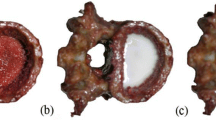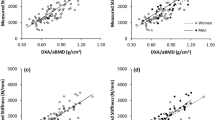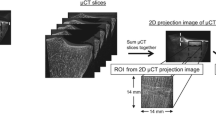Abstract
We investigated whether trabecular microstructural parameters determined in multislice spiral computed tomographic (MSCT) images of proximal femur specimens differed in male and female donors and improved the prediction of biomechanical strength of the femur compared to bone mineral density (BMD) and content (BMC) determined with dual X-ray absorptiometry (DXA) as the standard diagnostic technique. Proximal femur specimens (n = 119) were harvested from formalin-fixed human cadavers (mean age 80 ± 10 years). BMD was determined using DXA. Trabecular microstructural parameters (bone volume fraction, fractal dimension, and trabecular thickness, spacing, and number) were calculated in MSCT-derived images of the proximal femur. Failure load (FL) was measured using a biomechanical side-impact test. An age-, height-, and weight-matched subgroup (n = 54) was chosen to compare male and female donors. BMC, BMD, and structural parameters correlated significantly with FL, with r up to 0.75, 0.71, and 0.71, respectively. In a multiple regression model, an increase up to r = 0.82 was obtained when combining trabecular structural parameters and BMC. BMD differed between males and females only at the trochanter. BMC showed significant gender differences in all regions. This experimental study showed that a combination of BMC and microstructural parameters could improve the prediction of FL, suggesting that bone mass and trabecular structure carry overlapping but complementary information and that a combination of the two provides the best prediction of bone strength. Male donors had larger femora even after adjustment for body size and height, but no differences in trabecular structure were found between males and females.




Similar content being viewed by others
References
Adachi JD, Loannidis G, Berger C, Joseph L, Papaioannou A, Pickard L, Papadimitropoulos EA, Hopman W, Poliquin S, Prior JC, Hanley DA, Olszynski WP, Anastassiades T, Brown JP, Murray T, Jackson SA, Tenenhouse A (2001) The influence of osteoporotic fractures on health-related quality of life in community-dwelling men and women across Canada. Osteoporos Int 12:903–908
McBroom RJ, Hayes WC, Edwards WT, Goldberg RP, White AA III (1985) Prediction of vertebral body compressive fracture using quantitative computed tomography. J Bone Joint Surg Am 67:1206–1214
Eckstein F, Lochmuller EM, Lill CA, Kuhn V, Schneider E, Delling G, Muller R (2002) Bone strength at clinically relevant sites displays substantial heterogeneity and is best predicted from site-specific bone densitometry. J Bone Miner Res 17:162–171
Lochmuller EM, Burklein D, Kuhn V, Glaser C, Muller R, Gluer CC, Eckstein F (2002) Mechanical strength of the thoracolumbar spine in the elderly: prediction from in situ dual-energy X-ray absorptiometry, quantitative computed tomography (QCT), upper and lower limb peripheral QCT, and quantitative ultrasound. Bone 31:77–84
Ott S (1986) Should women get screening bone mass measurements? Ann Intern Med 104:874–876
Link TM (2001) Changes in trabecular bone structure assessed by high-resolution MRI in patients after transplantation. Adv Exp Med Biol 496:31–36
Link T, Majumdar S, Augat P, Lin J, Newitt D, Lu Y, Lane N, Genant H (1998) In vivo high resolution MRI of the calcaneus: differences in trabecular structure in osteoporosis patients. J Bone Miner Res 13:1175–1182
Link T, Saborowski S, Kisters K, Kempkes M, Kosch M, Newitt D, Lu Y, Waldt S, Majumdar S (2002) Changes in calcaneal trabecular bone structure assessed with high resolution MRI in patients with kidney transplantation. Osteoporos Int 2002:119–129
Abrahamsen B, Hansen TB, Jensen LB, Hermann AP, Eiken P (1997) Site of osteodensitometry in perimenopausal women: correlation and limits of agreement between anatomic regions. J Bone Miner Res 12:1471–1479
Link TM, Vieth V, Stehling C, Lotter A, Beer A, Newitt D, Majumdar S (2003) High-resolution MRI vs multislice spiral CT: which technique depicts the trabecular bone structure best? Eur Radiol 13:663–671
Bauer JS, Issever AS, Fischbeck M, Burghardt A, Eckstein F, Rummeny EJ, Majumdar S, Link TM (2004) Multislice-CT for structure analysis of trabecular bone - a comparison with micro-CT and biomechanical strength [in German]. Rofo Fortschr Geb Rontgenstr Neuen Bildgeb Verfahr 176:709–718
Parfitt M, Drezner M, Glorieux F, Kanis J, Malluche H, Meunier P, Ott S, Recker R (1987) Bone histomorphometry: standardization of nomenclature, symbols and units. Report of the ASBMR Histomorphometry Nomenclature Committee. J Bone Miner Res 2:595–610
Link TM, Majumdar S, Lin JC, Newitt D, Augat P, Ouyang X, Mathur A, Genant HK (1998) A comparative study of trabecular bone properties in the spine and femur using high resolution MRI and CT. J Bone Miner Res 13:122–132
Issever AS, Vieth V, Lotter A, Meier N, Laib A, Newitt D, Majumdar S, Link TM (2002) Local differences in the trabecular bone structure of the proximal femur depicted with high-spatial-resolution MR imaging and multisection CT. Acad Radiol 9:1395–1406
Eckstein F, Wunderer C, Boehm H, Kuhn V, Priemel M, Link TM, Lochmuller EM (2004) Reproducibility and side differences of mechanical tests for determining the structural strength of the proximal femur. J Bone Miner Res 19:379–385
Gluer CC, Blake G, Lu Y, Blunt BA, Jergas M, Genant HK (1995) Accurate assessment of precision errors: how to measure the reproducibility of bone densitometry techniques. Osteoporos Int 5:262–270
Link TM, Vieth V, Langenberg R, Meier N, Lotter A, Newitt D, Majumdar S (2003) Structure analysis of high resolution magnetic resonance imaging of the proximal femur: in vitro correlation with biomechanical strength and BMD. Calcif Tissue Int 72:156–165
Amling M, Herden S, Poesl M, Hahn M, Ritzel H, Delling G (1996) Heterogeneity of the skeleton: comparison of the trabecular microarchitecture of the spine, the iliac crest, the femur and the calcaneus. J Bone Miner Res 11:36–45
Parfitt AM (1987) Trabecular bone architecture in the pathogenesis and prevention of fracture. Am J Med 82(suppl 1B):68–72
Cheng X, Lowet G, Boonen S, Nicholson P, Brys P, Nijs J, Dequeker J (1997) Assessment of the strength of the proximal femur in vitro: relationship to femoral bone mineral density and femoral geometry. Bone 20:213–218
Lochmuller EM, Muller R, Kuhn V, Lill CA, Eckstein F (2003) Can novel clinical densitometric techniques replace or improve DXA in predicting bone strength in osteoporosis at the hip and other skeletal sites? J Bone Miner Res 18:906–912
Stromsoe K, Hoiseth A, Alho A, Kok WL (1995) Bending strength of the femur in relation to non-invasive bone mineral assessment. J Biomech 28:857–861
Wachter NJ, Augat P, Mentzel M, Sarkar MR, Krischak GD, Kinzl L, Claes LE (2001) Predictive value of bone mineral density and morphology determined by peripheral quantitative computed tomography for cancellous bone strength of the proximal femur. Bone 28:133–139
Lin J, Grampp S, Link T, Kothari M, Newitt D, Felsenberg D, Majumdar S (1999) Fractal analysis of proximal femur radiographs: correlation with biomechanical properties and bone mineral density. Osteoporos Int 9:516-524
Buitrago-Tellez CH, Bonnaire F, Schulze C, Gufler H, Honninger A, Kuner E, Langer M (1997) Quantitative CT assessment of the proximal femur. Experimental studies on its correlation with breaking load in femoral neck fractures [in German]. Rofo Fortschr Geb Rontgenstr Neuen Bildgeb Verfahr 167:627–632
Prevrhal S, Meta M, Genant HK (2004) Two new regions of interest to evaluate separately cortical and trabecular BMD in the proximal femur using DXA. Osteoporos Int 15:12–19
Lunt M, Felsenberg D, Adams J, Benevolenskaya L, Cannata J, Dequeker J, Dodenhof C, Falch JA, Johnell O, Khaw KT, Masaryk P, Pols H, Poor G, Reid D, Scheidt-Nave C, Weber K, Silman AJ, Reeve J (1997) Population-based geographic variations in DXA bone density in Europe: the EVOS Study. European Vertebral Osteoporosis. Osteoporos Int 7:175-189
Seeman E (2002) Pathogenesis of bone fragility in women and men. Lancet 359:1841–1850
Petit MA, Beck TJ, Lin HM, Bentley C, Legro RS, Lloyd T (2004) Femoral bone structural geometry adapts to mechanical loading and is influenced by sex steroids: The Penn State Young Women’s Health Study. Bone 35:750–759
Olszynski WP, Shawn DK, Adachi JD, Brown JP, Cummings SR, Hanley DA, Harris SP, Hodsman AB, Kendler D, McClung MR, Miller PD, Yuen CK (2004) Osteoporosis in men: epidemiology, diagnosis, prevention, and treatment. Clin Ther 26:15–28
Link T, Vieth V, Matheis J, Newitt D, Lu Y, Rummeny E, Majumdar S (2002) Bone structure of the distal radius and the calcaneus versus BMD of the spine and proximal femur in the prediction of osteoporotic spine fractures. Eur Radiol 12:401–408
Majumdar S, Newitt D, Mathur A, Osman D, Gies A, Chiu E, Lotz J, Kinney J, Genant H (1996) Magnetic resonance imaging of trabecular bone structure in the distal radius: relationship with X-ray tomographic microscopy and biomechanics. Osteoporos Int 6:376–385
Majumdar S, Genant H, Grampp S, Newitt D, Truong V, Lin J, Mathur A (1997) Correlation of trabecular bone structure with age, bone mineral density and osteoporotic status: in vivo studies in the distal radius using high resolution magnetic resonance imaging. J Bone Miner Res 12:111–118
Ouyang X, Selby K, Lang P, Majumdar S, Genant H (1997) High resolution MR imaging of the calcaneus: age-related changes in trabecular structure and comparison with DXA measurements. Calcif Tissue Int 60:139–147
Dougherty G, Henebry GM (2002) Lacunarity analysis of spatial pattern in CT images of vertebral trabecular bone for assessing osteoporosis. Med Eng Phys 24:129-138
Link TM, Majumdar S, Lin JC, Augat P, Gould RG, Newitt D, Ouyang X, Lang TF, Mathur A, Genant HK (1998) Assessment of trabecular structure using high resolution CT images and texture analysis. J Comput Assist Tomogr 22:15–24
Waldt S, Meier N, Renger B, Lenzen H, Fiebich M, Rummeny EJ, Link TM (1999) The texture-analysis of high-resolution computed tomograms as an additional procedure in osteoporosis diagnosis: in-vitro studies on vertebral segments [in German]. Rofo Fortschr Geb Rontgenstr Neuen Bildgeb Verfahr 171:136–142
Luo ZP, Zhang L, Turner RT, An KN (2000) Effects of mechanical stress/strain and estrogen on cancellous bone structure predicted by fuzzy decision. IEEE Trans Biomed Eng 47:344–351
Chung H, Chu C, Underweiser M, Wehrli F (1994) On the fractal nature of trabecular structure. Med Phys 21:1535–1549
Majumdar S, Prasad R (1991) Fractal analysis for assessing trabecular structure. Radiology 181:188-189
Klotzbuecher CM, Ross PD, Landsman PB, Abbott TA III, Berger M (2000) Patients with prior fractures have an increased risk of future fractures: a summary of the literature and statistical synthesis. J Bone Miner Res 15:721–739
Currey JD, Brear K, Zioupos P, Reilly GC (1995) Effect of formaldehyde fixation on some mechanical properties of bovine bone. Biomaterials 16:1267–1271
Augat P, Reeb H, Claes LE (1996) Prediction of fracture load at different skeletal sites by geometric properties of the cortical shell. J Bone Miner Res 11:1356–1363
Lochmuller EM, Krefting N, Burklein D, Eckstein F (2001) Effect of fixation, soft-tissues, and scan projection on bone mineral measurements with dual energy X-ray absorptiometry (DXA). Calcif Tissue Int 68:140–145
Patel R, Seah M, Blake GM, Jefferies AL, Crane FM, Fogelman I (1996) Concordance and precision of dual X-ray absorptiometry with a 10 s scan. Br J Radiol 69:816–820
Patel R, Blake GM, Rymer J, Fogelman I (2000) Long-term precision of DXA scanning assessed over seven years in forty postmenopausal women. Osteoporos Int 11:68–75
Cody DD, Gross GJ, Hou FJ, Spencer HJ, Goldstein SA, Fyhrie DP (1999) Femoral strength is better predicted by finite element models than QCT and DXA. J Biomech 32:1013–1020
Newitt DC, van Rietbergen B, Majumdar S (2002) Processing and analysis of in vivo high-resolution MR images of trabecular bone for longitudinal studies: reproducibility of structural measures and micro-finite element analysis derived mechanical properties. Osteoporos Int 13:278–287
Boehm HF, Raeth C, Monetti RA, Mueller D, Newitt D, Majumdar S, Rummeny E, Morfill G, Link TM (2003) Local 3D scaling properties for the analysis of trabecular bone extracted from high-resolution magnetic resonance imaging of human trabecular bone: comparison with bone mineral density in the prediction of biomechanical strength in vitro. Invest Radiol 38:269–280
Acknowledgments
We thank Volker Kuhn and Maiko Matsuura for performing some of the biomechanical tests. This work was supported by a grant of the Deutsche Forschungsgemeinschaft (DFG LO 730/3-1).
Author information
Authors and Affiliations
Corresponding author
Rights and permissions
About this article
Cite this article
Bauer, J.S., Kohlmann, S., Eckstein, F. et al. Structural Analysis of Trabecular Bone of the Proximal Femur Using Multislice Computed Tomography: A Comparison with Dual X-Ray Absorptiometry for Predicting Biomechanical Strength In Vitro. Calcif Tissue Int 78, 78–89 (2006). https://doi.org/10.1007/s00223-005-0070-3
Received:
Accepted:
Published:
Issue Date:
DOI: https://doi.org/10.1007/s00223-005-0070-3




